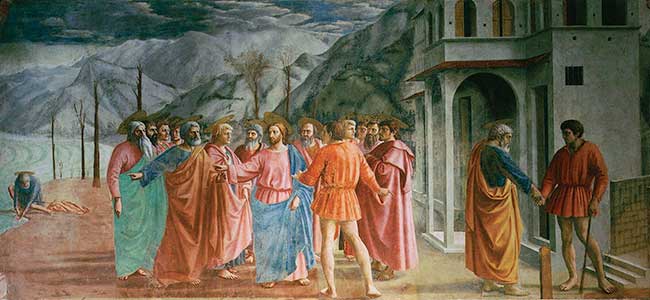The Tribute Money by Masaccio

THE MAGNIFICENT PAINTING above, known as the Tribute Money, is a fresco from the Brancacci Chapel in Florence, Italy, and is the work of the first great master of the Italian Renaissance, Masaccio (1401–1428). Masaccio’s work represents the shift from the highly stylized and decorative painting we associate with Medieval times to painting emphasizing three-dimensional space and solid, realistic human forms —the kind of painting we associate with the Italian Renaissance. Masaccio was one of the great heros of Michaelangelo, Leonardo DaVinci, and Raphael. In this painting, the story of Jesus, Peter, and the tribute money (see Matt 17:24ff) is told in three stages: the center of the painting is part 1, the left, part 2, and the right, part 3. In the center, the temple tax is required of Jesus by the tax collector. The tax collector addresses Peter, his left hand reaches toward Jesus in a gesture of asking, his right hand points down and in the direction of the temple building at the right, to show that the tax is for the earthly temple. Christ, pointing towards the lake, gives the instructions to Peter about how he will go about getting the money; Peter’s hand obediently follows his master’s gesture. Later, at the left, Peter retrieves the coin from the fish’s mouth—the amazing foretold miracle. Finally, at the right, Peter delivers the four-drachma coin to the tax collector.
After Jesus and his disciples arrived in Capernaum, the collectors of the drachma tax came to Peter and asked, “Doesn’t your teacher pay the temple tax?” “Yes, he does,” he replied.
Jesus said to him, “ . . . so that we may not offend them, go to the lake and throw out your line. Take the first fish you catch, open its mouth, and you will find a four-drachma coin.”
“Take it and give it to them for my tax and yours.”
View a large file of the Tribute Money on Wikipedia.
By the Editors
[Christian History originally published this article in Christian History Issue #19 in 1988]
Next articles
From the Archives: Andrew Carnegie
For Carnegie, “the surplus wealth of the few will become, in the best sense, the property of the many.”
Andrew CarnegieFrom the Archives: Desiderius Erasmus
The Despising of Riches (c 1488) Based on the translation by Thomas Paynells, as it appeared in the Bethelet edition of 1533.
Desiderius ErasmusWe’re Sorry Gladys . . . But God Can’t Use You in China
Gladys Aylward was told she’d never be able to learn Chinese.
the EditorsOld-Fashioned Wisdom from John Ploughman
This eloquent Baptist preacher of Victorian England was also loved for his earthy wisdom. Our text and engraving are taken from his popular writings John Ploughman’s Talk and John Ploughman’s Pictures. The homespun sage had much to say that, in his words, “would not suit well the pulpit or the Sabbath.”
John Ploughman


